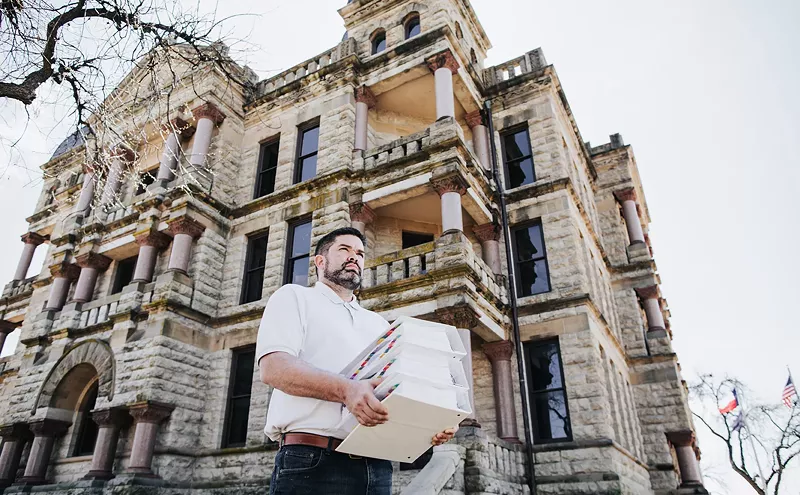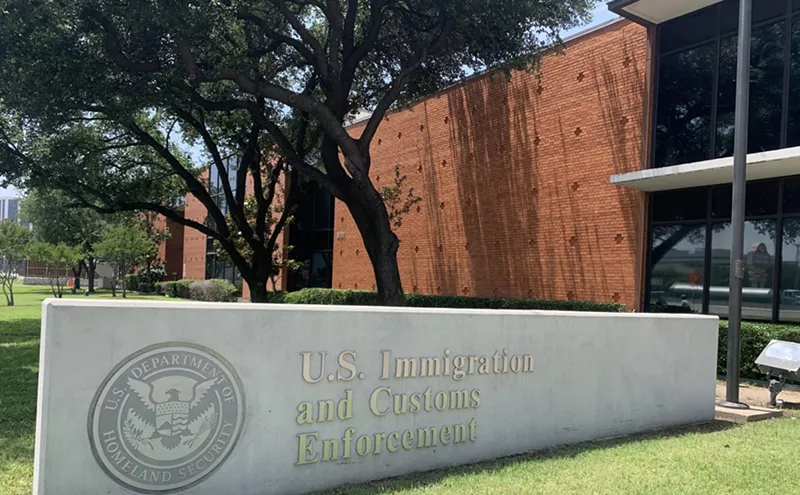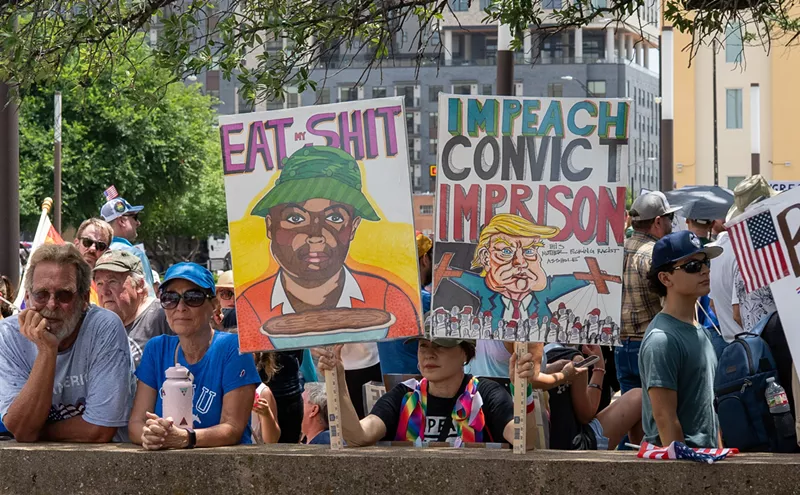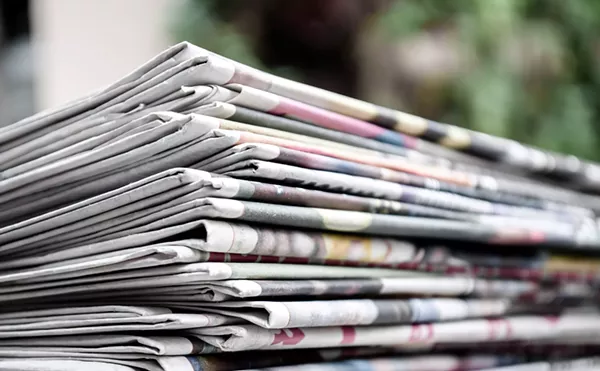But late in the day after the space shuttle Columbia blew up over Dallas, the body parts began to be found along the Louisiana border. About then, the eyes of the onlookers began to look less avid.
I stopped for gas at a cafe in Poyner, 85 miles from Dallas. Inside, the tables were crowded and the waitress harried. I was at the cash register waiting to pay when two men in camouflage clothes burst in and announced to diners that they had found pieces.
"There's chunks of it on my dad's ranch."
They jumped into a white pickup, and I followed Paul Arthur of Grapeland, on whose father's ranch the debris had fallen, and Gene Kolvig of Joshua, a buddy who helps with the cattle in exchange for hunting privileges. Both men are in their early 30s, muscular, tanned. They could have been dressed for war.
On the way down County Road 315 I had to swerve to avoid a stylishly dressed and coiffed young woman who had pulled her huge late-model SUV barely off the narrow road. She was on the side of the road, stooped, small hands at her waist, peering down at what appeared to be the black abandoned fender of a trailer or piece of farm equipment. Just as I passed she touched it squeamishly with her toe.
At the ranch Paul Arthur ducked under a barrier of plastic crime-scene tape erected a short time before by sheriff's deputies, now long gone. He extended one large black boot and kicked over what appeared to be a wafer of burned metal about the size of a pie tin.
Kolvig said, "You're not supposed to touch it."
Arthur shrugged apologetically.
All three of us hunkered over it, pondering.
"I wonder what it's made out of," Arthur said.
I was suppressing doubts. It lay two yards from a burn pile in which there were charred aluminum beer cans and other metal. On the back was indecipherable lettering in a bold commercial-looking font, which I thought might have said something like "Coca-Cola" at one time. I kept my own counsel and made my goodbyes.
But a few miles away on a narrow winding dirt road, I came across another small circle of yellow tape on stakes at the side of the road, and this remnant, very similar to the one at Arthur's father's ranch, was somehow clearly from a spaceship. I can't tell you how. I can't explain.
It was the same stuff I'd seen minutes before--metallic on the surface but frayed at the edges like Fiberglas. This piece bore a checkerboard pattern of raised bumps as if it had been a skin covering rivet heads. The pattern and the dull, desiccated texture said everything to me from Alien II to Buck Rogers. Nor can I express the wonder inspired by this small ragged object lying in red mud by the side of a back-country road. I wanted to touch it gingerly with my foot, because it was from Outer Space.
The radio had been warning all day that falling parts of the space shuttle might burn us, cause cancer or even be radioactive. But if I had been wearing combat boots like Arthur's, instead of loafers, I would have touched it anyway.
It was the first of February, incredibly warm and bright. On State Highway 155, a two-lane road going south toward Palestine, I drove up on a scene I associate with bluebonnets in spring--cars pulled over on both shoulders, hand-linked families scurrying through the slowed traffic like raccoons, people standing in the ditch grinning a little foolishly at cameras for the family photo album. A piece of metal 2 feet square, guarded by a sheriff's car and a state highway truck, was in the ditch behind yellow tape. People waited patiently in line to snap pictures of each other standing over it. I wondered what they would write next to their photos.
Farther south on 155 my police scanner began picking up the deputies, volunteer firemen, city police and citizens who were out in the woods finding and marking the locations of the pieces.
An older male voice: "North 31 degrees, 52.185, west 95 degrees, 36.64, a 2-inch-by-4-inch piece of charred fabric."
The female dispatcher: "That's a 10-4."
A younger male voice: "North 31.51.589, west 95.37.385, a piece of Fiberglas with an impeller or a fan on it, still intact."
I followed the voices down the debris trail south and east toward Nacogdoches and into the dusk. Along the way the same scene loomed again and again--police lights glittering on faces of people who had pulled over to look and take pictures, exhausted volunteers trudging in and out of the woods, the weary voices on the scanner calling in coordinates. After dark I pulled over and talked with Kenny Hensley, an investigator with the Nacogdoches District Attorney's Office. I said I had heard on the radio that a major federal deployment of some kind might be imminent.
"That would be nice," he said. "That would mean I could go home and eat."
I crossed the road and sat in my car for a while. Some combination of darkness, lurid police beacons, white headlights on faces and the nervousness of movement gave the scene a "War of the Worlds" quality.
I was listening to the radio: Now there was word of body parts found in the woods east of Nacogdoches, and I knew I had to be there in the morning. It took a long time to find a motel with a room to rent.
The next morning I went to the town square in Nacogdoches, where an impromptu memorial of cut flowers and bouquets was beginning to grow. Nacogdoches is an old town with roots in cotton. The 19th-century brick facades around the courthouse were almost obscured by a mountain range of gigantic television satellite trucks. Since the previous afternoon, television had been broadcasting images of a single small piece of debris on a parking lot next to a Dumpster, now patrolled by National Guardsmen.
Across the street behind a tape barrier were Gary and Janice Greening, retirees from Bloomington, Minnesota. They had been headed south through Texas in their motor home, already grieving, when a family member called them on their cell phone to tell them about the crash.
We made small talk for a while, talking about his years teaching high school chemistry. She interrupted: "You want to hear an interesting story?" She nudged him. "Tell him."
He winced and shrugged. "Oh, well, we have a... " He paused. "Her sister's oldest grandson was killed in an auto accident. We buried him on Monday."
Fighting back tears, she said, "He was born the week the other shuttle blew up"-- the January 28, 1986, Challenger explosion. "The other shuttle blew up on the week he was born, and this shuttle blew up on the week he died."
She wiped an eye with one finger. "He was a good kid. He didn't have his seatbelt on."
He said: "He hit a patch of ice and rolled."
She asked if his name could be in the story. He was Ryan Struckhoff, 17, of Kensington, Kansas.
On the other side of the square, Katy McClelland had come down with her grandson on the way from church to see the chunk that had been video-looped on CNN for the past two days. She talked about the deaths. "It's sad that people lost their lives. But that's the way we have America set up. We're adventurous people.
"When you leave home, you're going to church or to town or something, you never know if you're going to make it back. You lose your life for less important things."
At the end of Sunday the media types were all congregating in Hemphill, a very small town positioned midway between the Sam Rayburn and Toledo Bend reservoirs in the southeastern part of Texas, because Hemphill was where the body parts were being brought. I knew why we had to be there--I have been at this too long to play the ingenue--but I decided to make someone else say it. I spied Ben Fenwick prowling through the dish trucks, gray-headed, notebook in hand. I had never seen him before in my life, but he had a certain seasoned look about the eye. He's a stringer for the Reuters news service working out of Oklahoma City.
I asked him to tell me why the body parts were so important to us. He told me he had covered the Oklahoma City bombing, tornadoes, bridge collapses. "I'm not new to this." He said the news of the bodies is important to us because it is the human beings, literally and physically, who are the most important story.
"People have to understand the human element in this. There are people in the spaceship, and those people have come to land here."
We look like ghouls standing around town with our cameras and notebooks, our tripods and satellite dishes at the ready, waiting for the remains to come in. But a ghoul is one who takes pleasure in loathsome things. The key is the pleasure. After the body parts began to be found, I didn't see any pleasure along the debris trail. Excitement had faded to grief.
Life is full of loathsome things that must be dealt with, few more loathsome than death. All of our sometimes weird ways of dealing with death, taken together, make up the rite of public funeral: the people taking bluebonnet pictures, the touching of the pieces, the voices calling coordinates from the woods, the Greenings mingling their tears with the tears of the bereaved astronaut families.
It is the way we reach out into space as a species, pull the space heroes back and fold them into the bosom of our planet, as if they had died in our arms.












